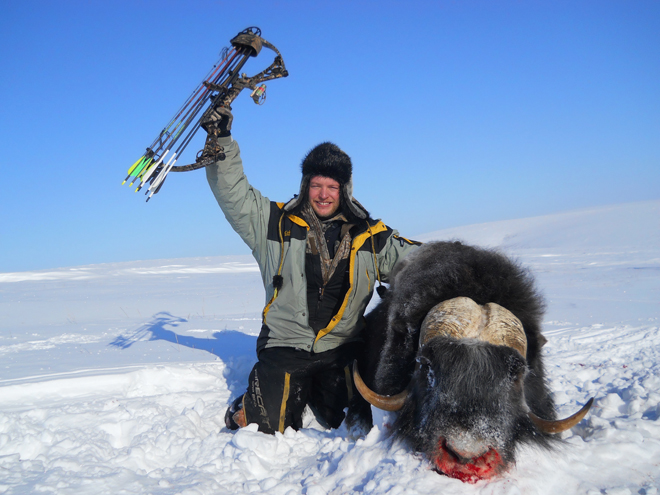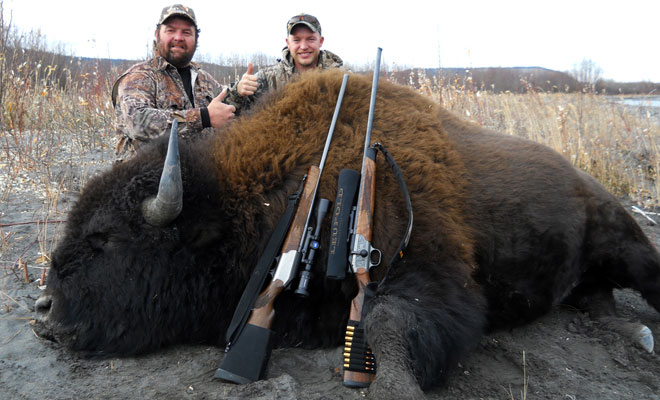Luck of the Draw
by Ryan Schmidt
Alaska, the Last Frontier—plenty of accessible game and thousands of miles to hunt. Well, this is what everyone that comes up to Alaska thinks, but it can be far from true.
Alaska can be an expensive place to hunt, for residents and non-residents alike. With the remote nature of the state it can be tough to find trophy game, or even to fill your freezer. One option that makes it a little easier is the Alaska draw system.
Every year thousands of people decide what permits they want to apply for. At either $5 or $10 for most permit choices, it is not too expensive to apply. This is not a points-based system, so someone that has been putting in for 30 years has the same chance as someone who puts in for the first time. There are plenty of good and bad aspects about the Alaska draw system, but that is not what we are going to discuss. We’re going to talk purely about success instead.
A few years ago, a longtime friend, Rob Lamberty, moved to Alaska, where I live, hunt and teach. I told him to apply for the permits, as I had for years, and to just consider it a donation to the Alaska Department of Fish and Game. Every year, I explained, I sent off my application for these permits, waited for February when they are released, and then was hit with crushing disappointment. Zero results.
So, properly warned, Rob and I sat down on a very cold December night and went through the drawing application. We put in for everything that we wanted and sent it off with very few expectations. Two months later, however, the permits came out and we had each drawn a tag. Rob drew the Copper River buffalo tag, and I drew a Nome muskox tag. Another good friend of mine, Ty Mase, drew a Nunivak Island muskox tag. Ty and I had been applying for many years for a muskox permit, so it was pretty coincidental that we finally drew one on the same year.
Rob, on the other hand, drew a bison tag on his first try. Talk about luck of the draw. Over 21,000 people put in for the bison tags annually, with less than a 1% chance of being drawn. With such luck we decided to accompany each other on our hunts.
October was fast approaching, and Rob was getting excited about his chance at an Alaska bison. But as a lot of you know, nothing comes cheap with a hunt up here. It starts with a $10 permit and then adds up from there. In fact, a lot of the time people don’t even hunt with the permits that get drawn, after they find out how expensive it will be. So take some time and check out your permits before applying for them and be prepared to spend a few dollars on the hunt.
In this case, Rob had to buy an Ahtna, Inc. land-use permit for $1,500 to hunt the Native lands (Ahtna does not allow hunting on its lands except for the special bison permit and for predator-control hunting). Then, after researching the area, we decided we didn’t have the right gear or equipment to cross the Copper River, so Rob decided to go with a guide.
During the first week of October, we were blasting up the Copper River in a jet boat in pursuit of an old bison. The day was spent climbing bluffs, looking for animals that were accessible. We saw a few bison high in the bluffs, but they were a few miles from the river, so we continued looking for something a little closer. Very similar to sheep hunting, the animals were on top of these steep bluffs that the river has cut over thousands of years. Bison trails could be seen for miles, zigzagging up and down the river bluffs. The river was fast-flowing with large rapids and looking grey to sky blue at times.
About 3 p.m. Rob spotted a big bull that came out of the willows and was working his way towards us about a half-mile away. We started our stalk through the river bottom. Rob was shooting a Blaser .375 HH, with 300-grain Barnes triple-shock rounds. We maneuvered downwind and stalked within 150 yards of the old bull, and with one shot the huge bison dropped to his knees and fell over.
Now the work began. Bison are over 1,500 pounds, and it took us nine huge, heavy pack loads to get the meat out. Then it took another trip to pull the hide and head out. And this was with luck on our side—the big bull had dropped only a little over a quarter-mile from the boat.
As we cut up meat, the wind started to pick up and sand and silt blew in our smiles as we made long trips back and forth to the boat. The Copper Riveris a beautiful place in the fall, and I realize why so many people apply for a bison permit. It’s truly a once-in-a-lifetime hunt.
Our next adventure found us flying to Nome and then on to Brevig Mission in early-March temperatures of 50-below. It was my turn to try to fill a drawing permit for a muskox.

Muskox are hardy animals, slightly prehistoric looking, and surviving—even thriving—in the conditions they do, is pretty amazing to behold. The long, flowing hair of the muskox, typically gnarled with ice and knots, is ten times warmer than wool—that helps.
As for the hunt, after buying my $500 metal tag, a pair of airline tickets and booking with guide Brian Simpson, costs were adding up. The guide portion for this hunt was again a no-brainer—Brian knew the area and had the right equipment and a warm place to stay. When our plane landed, the snowmachines were waiting for us, and we jumped on the sled for our ride to camp. The wind was blowing 50 mph, and the temperature was 60-below with the wind chill. I have been in -30- to 40-below before, but it is a different kind of cold, a cold that goes right through you. Good, professional-grade gear is a must on these winter hunts. Our sealskin fur hats and mittens and Baffin boots were lifesavers.
Once at camp, we were weathered in for two days with high winds and very cold temperatures. A Native family took good care of us and fed us very well. Rob and I toured the town, and the people were very friendly. The kids of Brevig Mission wanted to know why we traveled all that way to hunt a stinky muskox.
On day three the weather broke and we suited up—layers upon layers, including fur hat, boots, mittens, hand warmers, neck warmers, longjohns, snow pants, wool socks and more. We looked like two Michelin men, but were also ready to face Mother Nature at her extreme. I strapped my Mathews bow to the sled and we were ready to hunt.
We headed across the Bering Sea on our snowmachines—mine was an old Polaris with 30,000 miles on it!—bouncing across windswept drifts and broken ice shelves on our way to the hunt area. When hunting muskox, you want to look for an old bull with large, square bosses. There should be little hair between the horns. Color does not matter, though some say the older bulls have darker horns (I have seen old, white bosses as well). As a general rule, however, younger bulls and cows will have whiter bosses, not real big and with lots of hair between them. Study all the muskox and make sure you pick out a good one before taking the shot.
As we approached land, the wind started to die down and the sun broke out. With balmy 35-below temps, and 20 mph winds, we were officially hunting muskox. The sun was shining bright, and combined with the cold air, sundogs were created, looking like balls of fire coming from the snow. We found some muskox tracks and began picking our way through the windblown hills, following the sign. It took us the better part of the day to finally spot some muskox, about a dozen on top of the highest hill. Some were on the lookout for danger, while others where bedded down enjoying the sunshine. We made a plan to go after them.
There were two good bulls in the herd—one was broomed and the other was not. I decided to try for the non-broomed muskox. As we got ready to make our move, the muskox came charging down the hill, running wide open. The snow and ice flew, but I did not know if I should jump behind my sled or run. I was amazed at how majestic these animals were, and remained frozen where I stood.
The muskox stopped and looked at us for a split second, then took off again, the snow flying and long hair swaying back and forth. We took our time and maneuvered towards an old bull with huge bosses that looked like a true trophy. I drew back my bow and let the Slick Trick go; the bull ran about 60 yards and dropped.
As I drove my snowmachine back across the Bering Sea, with my iced-up muskox in the back of the sled, I realized the trip had been worth every penny.
At the same time, my good friend Ty Mase and his father, Tim Mase, were hunting Nunivak Island for muskox. Ty reported that they had a great adventure as well, taking a solid bull with his bow. For both hunting locations, logistics, weather and timing are critical obstacles that must be dealt with. Plan on the weather being at its worst, causing missed hunting days; plan for the possibility of canceled flights in and out, and leave enough time in between and you will get a chance at a trophy muskox. There are a few options to hunt muskox in Alaska—it might be hard to get a tag, but it’s well worth it when you do.
Permit hunts can be some of the best Alaska has to offer, but they will take time and money. So keep “donating” to the state—you never know what the “luck of the draw” might bring your way. For Rob, Ty and I, these were once-in-a-lifetime hunts that will never be forgotten.
###
Ryan Schmidt has a passion for hunting the backcountry and the remote wilderness of Alaska. He has over 20 years of big-game hunting experience and works as a rural educator in Alaska.

